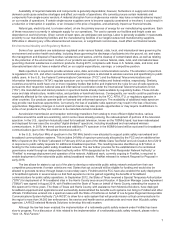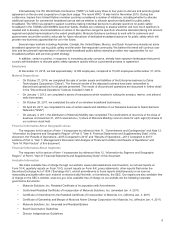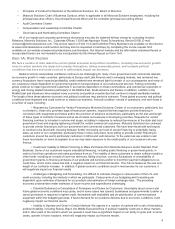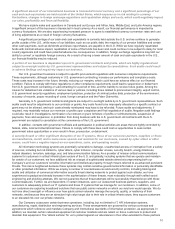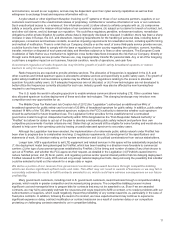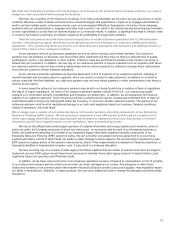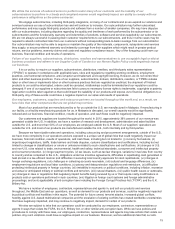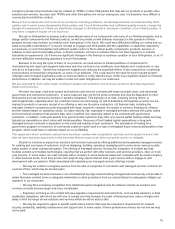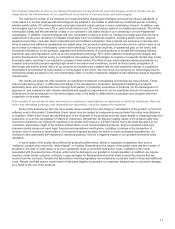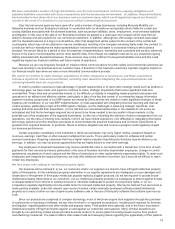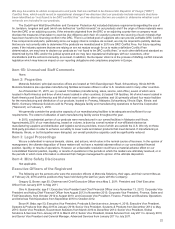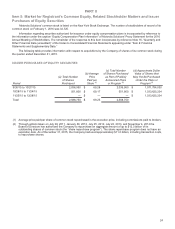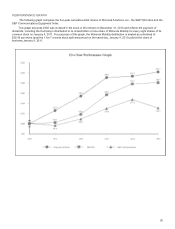Motorola 2015 Annual Report Download - page 18
Download and view the complete annual report
Please find page 18 of the 2015 Motorola annual report below. You can navigate through the pages in the report by either clicking on the pages listed below, or by using the keyword search tool below to find specific information within the annual report.17
Our success depends in part on our timely introduction of new products and technologies and our results can be
impacted by the effectiveness of our significant investments in new products and technologies.
The markets for certain of our products are characterized by changing technologies and evolving industry standards. In
some cases it is unclear what specific technology will be adopted in the market or what delivery model will prevail, including
whether public safety LTE will be delivered via private networks, public carriers or some combination thereof. In addition, new
technologies such as voice over LTE or push-to-talk clients over LTE could reduce sales of our traditional products. The shift to
smart public safety and the prevalence of data in our customer’s use cases results in our competing in a more fragmented
marketplace. In addition, new technologies and new competitors continue to enter our markets at a faster pace than we have
experienced in the past, resulting in increased competition from non-traditional suppliers, including public carriers, telecom
equipment providers, consumer device manufacturers and software companies. New products are expensive to develop and
bring to market and additional complexities are added when this process is outsourced as we have done in certain cases or as
we increase our reliance on third-party content and technology. Our success depends, in substantial part, on the timely and
successful introduction of new products, upgrades and enhancements of current products to comply with emerging industry
standards, laws and regulations, such as China's proprietary technology, PDT, and to address competing technological and
product developments carried out by our competitors. Developing new technologies to compete in a specific market may not be
financially viable, resulting in our inability to compete in that market. The R&D of new, technologically-advanced products is a
complex and uncertain process requiring high levels of innovation and investment, as well as the accurate anticipation of
technology and market trends. Many of our products and systems are complex and we may experience delays in completing
development and introducing new products or technologies in the future. We may focus our resources on technologies that do
not become widely accepted or are not commercially viable or involve compliance obligations with additional areas of regulatory
requirements.
Our results are subject to risks related to our significant investment in developing and introducing new products. These
risks include among others: (i) difficulties and delays in the development, production, testing and marketing of products,
particularly when such activities are done through third-parties, (ii) customer acceptance of products, (iii) the development of,
approval of, and compliance with industry standards and regulatory requirements, (iv) the significant amount of resources we
must devote to the development of new technologies, and (v) the ability to differentiate our products and compete with other
companies in the same markets.
If the quality of our products does not meet our customers' expectations or regulatory or industry standards, then our
sales and operating earnings, and ultimately our reputation, could be negatively impacted.
Some of the products we sell may have quality issues resulting from the design or manufacture of the product, or from the
software used in the product. Sometimes, these issues may be caused by components we purchase from other manufacturers
or suppliers. Often these issues are identified prior to the shipment of the products and may cause delays in shipping products to
customers, or even the cancellation of orders by customers. Sometimes, we discover quality issues in the products after they
have been shipped to our customers, requiring us to resolve such issues in a timely manner that is the least disruptive to our
customers, particularly in light of the mission-critical nature of our communications products. Such pre-shipment and post-
shipment quality issues can have legal, financial and reputational ramifications, including: (i) delays in the recognition of
revenue, loss of revenue or future orders, (ii) customer-imposed penalties for failure to meet contractual requirements, (iii)
increased costs associated with repairing or replacing products, and (iv) a negative impact on our goodwill and brand name
reputation.
In some cases, if the quality issue affects the product's performance, safety or regulatory compliance, then such a
“defective” product may need to be “stop-shipped” or recalled. Depending on the nature of the quality issue and the number of
products in the field, it could cause us to incur substantial recall or corrective field action costs, in addition to the costs
associated with the potential loss of future orders and the damage to our goodwill or brand reputation. In addition, we may be
required, under certain customer contracts, to pay damages for failed performance that might exceed the revenue that we
receive from the contracts. Recalls and field actions involving regulatory non-compliance could also result in fines and additional
costs. Recalls and field actions could result in third-party litigation by persons or companies alleging harm or economic damage
as a result of the use of the products.


